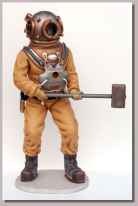In light of the workshop below, I thought you might enjoy this REPOST from DSN March 24, 2006
 This is one in a series of articles about deep-sea mining, a story Craig McClain has been covering dutifully. In this piece, molten fluids are shown to pump through deep volcanic vents offshore Papua New Guinea (PNG) in the Bismarck Sea, Manus Basin and Solomon Sea. As you may know from previous posts, these vents precipitate chimneys rich with copper and gold.
This is one in a series of articles about deep-sea mining, a story Craig McClain has been covering dutifully. In this piece, molten fluids are shown to pump through deep volcanic vents offshore Papua New Guinea (PNG) in the Bismarck Sea, Manus Basin and Solomon Sea. As you may know from previous posts, these vents precipitate chimneys rich with copper and gold.
Nautilus Minerals plans to conduct ‘surgical mining’ operations on these submerged volcanic vents. Metal sulphide deposits were also found in two ‘dead’ vent fields. The Suzette field measured 280,000 sq meters in area and the smaller Crawfield 100,000 sq meters. Dredge sampling produced samples averaging 15.5 g/t gold and 12.2% copper. According to an article at Minesite.com, terrestrial grades this rich would normally stimulate a mining rush, and ‘send oldtimers into ecstasies’.
The recent article at Minesite makes for a real nice read on the deep mining situation, and an interesting industrial perspective. Only one little remark suggests the author hasn’t been reading their Deep Sea News…
“… before any environmental activists start muttering about possible destruction of coral it is worth pointing out that at the depths where Nautilus and Placer have been working the water temperature is fractionally above freezing and there ain’t no coral there.” – Minesite.com, March 9, 2006
Should we make a wager? Hexacorals and octocorals are both common at 1000 meters in many parts of the world’s ocean. Ambient temperatures in these habitats average 2-4 Celsius. The deepest record for an octocoral is 6620 m, according to Dr. Stephen Cairns, a deep-coral expert at the Smithsonian Institution’s National Museum of Natural History.
 Afterword: The deep-sea azoic hypothesis has been fairly well repudiated for deep-sea biologists, but does the mindset still prevail for commercial and industrial diving? Deep Sea News maintains a list of deep-sea coral depth records, showing that cup, black, and gorgonian corals all occur deeper than 1000 m. Deep corals are higher in diversity than shallow corals (Cairns 2007). Furthermore, the PNG region (where Nautilus plans to operate) has the highest diversity for deep-sea corals in the world. The Coral Triangle is the epicenter of global marine biodiversity. Why would we mine vents there first?
Afterword: The deep-sea azoic hypothesis has been fairly well repudiated for deep-sea biologists, but does the mindset still prevail for commercial and industrial diving? Deep Sea News maintains a list of deep-sea coral depth records, showing that cup, black, and gorgonian corals all occur deeper than 1000 m. Deep corals are higher in diversity than shallow corals (Cairns 2007). Furthermore, the PNG region (where Nautilus plans to operate) has the highest diversity for deep-sea corals in the world. The Coral Triangle is the epicenter of global marine biodiversity. Why would we mine vents there first?
Reference:
Cairns, S.D. (2007). Deep-water corals: an overview with special reference to diversity and distribution of deep-water scleractinian corals. Bulletin of Marine Science, 81(3): 311-322.






Nice Site layout for your blog. I am looking forward to reading more from you.
Tom Humes
Peter asks: The Coral Triangle is the epicenter of global marine biodiversity. Why would we mine vents there first?
I would wager that the lax environmental checks and balances in PNG make it a very attractive first stop for unproven methods and questionable proposed mitigation in deep sea resource extraction.
That makes sense. Are the target vent fields closer to shore than other known sites, providing easier access, for example? Gold is priced at $900/oz. now, so pressure to mine these vents must be growing.
solwara prospects 1-8 are situated relatively close to the coast of new ireland province, albeit in deep water…
since rabaul is their land-based staging/processing area, the prospect sites are convenient…
That’s important for costs and logistics. One reason MBARI is where it is- convenient access to deep-water. That’s how they can dive so often.
I received some good news from InterRidge today, people are signing up. I wonder if the workshop will focus on PNG and Nautilus, or not. Seems hard to have a SMS workshop without this very important example.
Peter, it is really copper they are after. That price has rapidly dropped down to 2004 levels recently, which is one if the reasons they might have delayed building their ship. Waiting for prices to rise again to gain back investors (my guess, based on nothing).
There needs to be more discussion about mining code and ethics though, at the international level. I hope some of this will be discussed at the upcoming meeting.